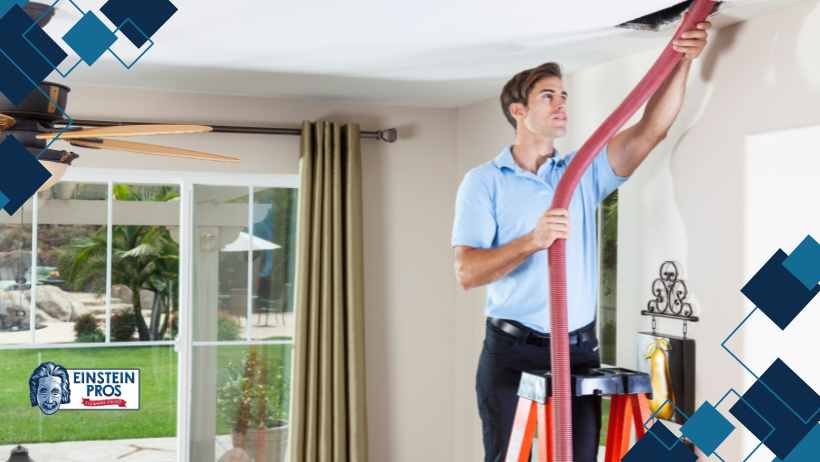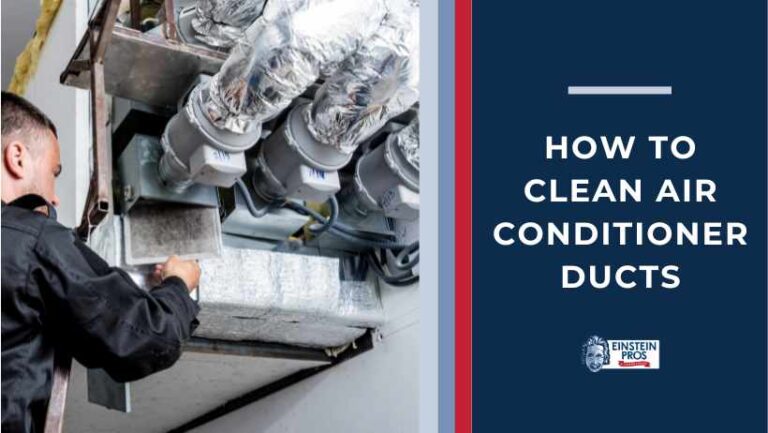Air conditioner ducts are the unsung heroes of our HVAC systems, silently working to distribute conditioned air throughout our living spaces. As air circulates through these ducts, it can carry with it dust, allergens, and other particles that gradually accumulate over time. This can be a source of diseases, hence one must know how to clean air conditioner ducts.
What are AC Ducts?
Air conditioner ducts are a crucial component of HVAC (Heating, Ventilation, and Air Conditioning) systems, serving as intricate pathways that facilitate the distribution of conditioned air throughout indoor spaces. These ducts are typically made from metal, fiberglass, or other durable substances. Their primary function is to ensure that the air, whether heated or cooled, reaches every corner of a building, maintaining a comfortable and consistent temperature.
Designed with precision, air conditioner ducts form an interconnected network that spans walls, ceilings, and floors, strategically placed to provide optimal air circulation. As the HVAC system generates conditioned air, these ducts act as conduits, guiding the air from the central unit to individual rooms or areas. The efficiency of this process is critical for the overall performance of the HVAC system and, consequently, the comfort and well-being of the occupants.
Importance of Clean Air Conditioner Ducts
Enhanced Indoor Air Quality:
- The significance of maintaining clean air conditioner ducts cannot be overstated. Over time, these ducts can become breeding grounds for dust, pollen, and other allergens. Regular cleaning ensures that the air circulating in your home is free from these harmful particles, contributing to a healthier indoor environment.
Energy Efficiency:
- Clean ducts translate to improved airflow, allowing your HVAC system to operate more efficiently. This efficiency not only leads to energy savings but also extends the lifespan of your system, reducing the need for frequent repairs or replacements.
Health Benefits:
- Mold and bacteria can thrive in the dark, damp recesses of neglected ducts. Breathing in air contaminated with these microorganisms can lead to respiratory issues. Keeping your ducts clean is a preventive measure that promotes the well-being of your household or office occupants.
Maintenance Tips for Air Conditioner Ducts
Now that we comprehend the importance of clean air conditioner ducts, let’s explore practical air conditioner maintenance tips to ensure they remain in optimal condition.
Regular Inspection
Visual Inspection:
- Before diving into cleaning procedures, start with a visual inspection. Examine your ductwork for any visible signs of dirt, mold, or damage. Pay special attention to joints and connections, as these areas are prone to leaks.
Professional Inspection:
- While DIY inspections are valuable, scheduling regular inspections by a qualified HVAC professional is essential. Professionals have the expertise to identify issues that may not be immediately apparent and can recommend appropriate actions.
3. Cleaning Techniques
DIY Cleaning:
- For routine maintenance, use a vacuum cleaner with a brush attachment to remove loose debris from accessible duct surfaces. Follow up by wiping down the surfaces with a damp cloth to capture any remaining dust or dirt particles.
Professional Duct Cleaning Services:
- Consider professional duct cleaning services for a more thorough cleaning. These services employ specialized equipment to dislodge and remove debris from the entire duct system, ensuring a comprehensive cleaning.
Duct Sanitization:
- In addition to cleaning, incorporating antimicrobial treatments or sanitizers can eliminate mold, bacteria, and other microorganisms. Always follow manufacturer guidelines and consult with professionals for safe and effective sanitization.
4. Filter Replacement
Regular Filter Changes:
- The air filter in your HVAC system acts as the first line of defense against airborne particles. If the air filter is clogged, replace the filter every three months or as recommended by the manufacturer to ensure optimal performance.
High-Quality Filters:
- Investing in HEPA filters is a wise choice, especially for those with respiratory conditions. These filters trap smaller particles, further improving indoor air quality.
5. Seal Leaks and Insulate
Duct Sealing:
- Inspect your ductwork for leaks, as even small gaps can lead to significant energy losses. Seal identified leaks using mastic or metal tape, ensuring a thorough job to maintain energy efficiency. If you need a clean AC duct in Phoenix, it’s best to call the professionals, especially as duct sealing is a complex process.
Insulation:
- Proper insulation is crucial, particularly for ducts located in unconditioned spaces like attics or crawlspaces. Insulating these ducts helps maintain the desired air temperature as it travels through the system.
6. Monitor Humidity Levels
Maintain Optimal Humidity:
- Controlling indoor humidity levels is key to preventing mold growth within the ducts. Use dehumidifiers in damp areas of the home and ensure proper ventilation to keep humidity in check.
Address Water Leaks Promptly:
- Timely AC repair of any leaks prevents moisture buildup in the ducts. Moisture can lead to mold growth, negatively impacting indoor air quality.
Air Conditioner Duct Repair Tips
In addition to regular maintenance, addressing issues with your air conditioner ducts promptly is crucial. Here are some repair tips to keep your ducts in optimal condition.
7. Identify and Fix Leaks
Smoke Test:
- Conducting a smoke test is a practical way to identify air leaks in the ductwork. Using a smoke pencil or incense stick near joints and connections can reveal any smoke movement, indicating potential leaks.
Sealing Leaks:
- Once leaks are identified, sealing them with mastic or metal tape is imperative. This step ensures that conditioned air is not lost, and the HVAC system operates at its intended efficiency.
8. Address Insulation Issues
Inspect Insulation:
- Regularly check the insulation on your ducts for signs of damage or wear. Damaged insulation compromises the system’s ability to maintain consistent temperatures.
Reinsulate as Needed:
- In cases of severely damaged or deteriorated insulation, consider reinsulating the affected sections of ductwork. Adequate insulation is vital for both energy efficiency and preventing condensation.
9. Professional Repairs
Ductwork Replacement:
- If your ducts are outdated or severely damaged, seek professional assistance for duct replacement. Modern materials may offer improved durability and energy efficiency.
HVAC System Evaluation:
- Persistent issues may indicate underlying problems with your entire HVAC system. Seeking professional evaluation and addressing these issues can prevent ongoing duct problems and optimize system performance.
10. DIY vs. Professional Repairs
DIY Repairs:
- Minor leaks or insulation issues may be suitable for DIY repairs. Ensure you have the necessary tools and materials, and follow safety guidelines to address these smaller-scale problems effectively.
Professional Assistance:
- For more complex issues such as extensive leaks or problems with the duct system design, seeking professional assistance is advisable. Professional “air duct cleaning near me” is a good investment as the technicians possess the expertise and equipment to handle intricate repairs effectively.

Additional Tips on How to Clean Air Conditioner Ducts
Addressing Restricted Airflow:
- Identification: If certain rooms consistently receive less airflow, it may indicate blockages or restrictions within the ducts.
- Resolution: Investigate and remove any obstacles such as furniture blocking vents, and check for obstructions within the ducts. Ensure that vents are open and unobstructed for optimal airflow.
Dealing with Unpleasant Odors:
- Identification: Unpleasant smells emanating from the vents can indicate the presence of mold, bacteria, or other contaminants within the duct system.
- Resolution: If you want clean AC duct Phoenix, introduce odor-neutralizing solutions into the ducts or consider professional duct cleaning services. Addressing the source of the odor, such as mold growth, is crucial for long-term effectiveness.
Handling Unusual Sounds:
- Identification: Strange noises like rattling, banging, or whistling coming from the ducts may suggest loose components, damaged insulation, or airflow issues.
- Resolution: Inspect the ducts for loose parts, secure connections, and ensure proper insulation. If issues persist, consult with HVAC professionals for a professional air duct cleaning service.
Dealing with Excessive Condensation:
- Identification: Condensation on or around duct surfaces may lead to moisture-related problems, including mold growth and structural damage.
- Resolution: Insulate ducts in areas with temperature differentials, such as attics or crawlspaces, to prevent condensation. Repair any leaks promptly, and consider using dehumidifiers in humid environments.
Optimizing Duct Design:
- Identification: Inefficient duct design can result in uneven airflow, temperature variations, and increased energy consumption.
- Resolution: Consult with HVAC professionals in Phoenix to evaluate and optimize duct design. This may involve redesigning duct layouts, resizing components, or implementing dampers to achieve better air distribution and energy efficiency.
General Cleaning Steps for Air Conditioner Ducts
Turn Off the HVAC System:
- Before beginning any cleaning procedures, turn off the HVAC system to ensure safety. This prevents the circulation of conditioned air during the cleaning process.
Locate and Access the Ducts:
- Identify the access points to the ductwork. Ducts may be accessible through vents or openings in walls, ceilings, or floors. Remove vent covers or access panels to reach the interior of the ducts.
Inspect for Visible Debris:
- Conduct a visual inspection of the ducts to identify any visible dust, dirt, or debris. Use a flashlight to illuminate the interior and inspect for mold or other contaminants.
Use a Vacuum Cleaner:
- For light to moderate debris, a vacuum cleaner with a brush attachment can be effective. Carefully vacuum the interior surfaces of the ducts, reaching as far as possible to remove loose particles.
Wipe Down Duct Surfaces:
- Dampen a cloth or rag with a mild cleaning solution and wipe down the interior surfaces of the ducts. This helps capture remaining dust and ensures a clean AC.
Consider Professional Cleaning:
- If the ducts are heavily soiled, or if there is evidence of mold or bacterial growth, consider hiring professional duct cleaning services. Professionals have specialized equipment to dislodge and remove stubborn debris.
Brand-Specific Considerations
While the general cleaning steps apply to most air conditioner ducts, it’s crucial to consider brand-specific recommendations for optimal results. Here are some brand-specific considerations:
1. Lennox:
- Lennox recommends regular visual inspections and cleaning as needed.
- Follow Lennox’s guidelines for cleaning agents, as some products may damage specific components.
2. Carrier:
- Carrier emphasizes the importance of changing or cleaning air filters regularly.
- Consult Carrier’s user manual for specific instructions on duct cleaning.
3. Trane:
- Trane suggests professional duct cleaning every 5-7 years.
- Use Trane-approved cleaning products if opting for a DIY approach.
4. Daikin:
- Daikin recommends inspecting and cleaning ducts annually.
- Ensure compatibility with Daikin’s recommended cleaning solutions.
5. Mitsubishi Electric:
- Mitsubishi Electric emphasizes the use of approved cleaning methods.
- Check the user manual for specific guidelines on duct maintenance.
Additional Tips to Clean AC Duct for All Brands
Inspect Duct Insulation:
- Check the insulation around ducts for damage or wear. Repair or replace damaged insulation to maintain energy efficiency.
Seal Duct Leaks:
- Identify and seal any leaks using mastic or metal tape. Proper sealing prevents conditioned air loss and maintains energy efficiency.
Consider UV Air Purifiers:
- Install UV air purifiers within the ductwork to eliminate mold, bacteria, and other microorganisms. Follow manufacturer recommendations for installation and maintenance.
Professional Inspection:
- Schedule regular inspections by HVAC professionals to assess the overall condition of the ducts as well as do a general professional HVAC service to assess your unit completely. Professionals can identify issues that may not be visible during a DIY inspection.
Conclusion
Maintaining clean and efficient air conditioner ducts is a fundamental aspect of ensuring a healthy indoor environment. By incorporating regular inspections from HVAC technicians at Einstein Pros, proper cleaning techniques, and timely repairs, you can keep your ducts in optimal condition.
